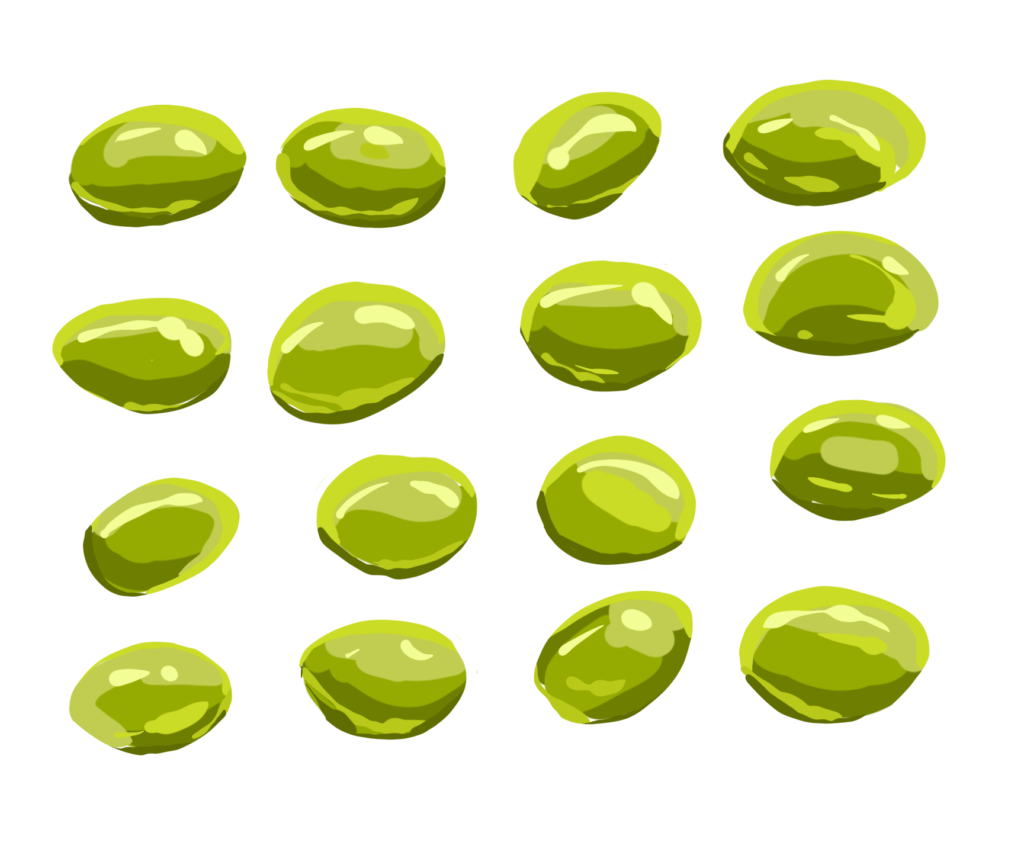
While vegetarian diets are better for the planet, many people worry about getting enough protein without eating meat. Whether a fears of being hungry all the time or deprivation of key nutrients, a vegetarian protein rich foods list can help.
Have no fear! There are plenty of ways to get more than enough protein in your meals without too much stress.
Protein Rich Food for Vegetarians
There are so many protein options for the vegetarian-curious. Let’s dive into our shame-free list of vegetarian protein rich foods that are more climate-friendly.
Food #1 Lentils
A top climate-friendly protein, lentils pack a punch when it comes to protein. 12 grams of protein per half cup of cooked lentils. And EWG ranks it as one of the most climate-friendly proteins, producing 1.9 pounds of carbon pollution for every 2.2 pounds of beans consumed.
How to prepare
- Rinse lentils for 5-10 seconds to remove dust or debris.
- Add 3 parts water for every 1 part lentils. So 1 cup of lentils needs 3 cups of water. Use broth for an extra flavor boost.
- Bring to a boil. Reduce heat to simmer and cover.
- For whole lentils, simmer for 15-20 minutes. For split red lentils, simmer for 5-7 minutes.
Spring & Summer Dishes
We’ll leave recipes to the pros – check out a few of our favorites!
SPRING LENTIL SALAD WITH ROASTED ASPARAGUS & POTATOES From Chelsea at Baked Greens. Deliciousness in 25 minutes? YES, PLEASE!
Another amazing option? French Lentil & Brussels Sprout Salad.
Check it out at Flourist. Delicious mediterranean flavors and fresh!
Another delicious summer option? Don’t skip this Summer Lentil Salad from Kitchen Confidante! The cucumbers bring some serious crunch and the mint adds extra zing.
Food #2 Milk
Dairy milks offer about 8 grams of protein per cup while dairy-free alternatives like soy milk offer close to 8 grams, hemp around 4 grams, flax and oat milk offer around 3 grams of protein.
Now let’s dive into some of the different milk options!
Dairy Milk $
One 8-ounce glass of dairy milk is equivalent to around 1 pound of carbon pollution. For coffee drinkers, this more than doubles the carbon footprint of your morning fuel. A cup of coffee goes from 21 grams of carbon pollution to 53 grams of carbon pollution.
While dairy milk offers a lower-pollution protein option compared to others, other types of milk offer an even smaller pollution footprint.
Soy Milk $$
You can just about halve the carbon footprint of your milk by switching to soy milk. One 8-ounce glass of soy milk is equivalent to around .55 pounds of carbon pollution.
Soy is a great protein for most people. However if you’re in the 1% of the population that is allergic to soy, there are other great options for you.
Hemp, Flax, Oat Milk $$$
Oat milk has the most data available on carbon emissions. You can prevent around .07 pounds of carbon emissions with each 8-ounce glass of oat milk vs. soy milk. Each glass equates around .48 pounds of carbon pollution.
While studies still need to become public on the carbon emissions of processing hemp and flax, there is reason to be optimistic it’s as low as Oat milk.
Watch out for: added sugar. Unsweetened is your best bet to lower the sugar in your glass as well as keep your milk versatile for cooking.
Important note: There are many layers of environmental impacts for milks. It’s really hard to compare different impacts such as water usage to harmful waste draining from processing. To simplify our environmental lens, we only focus on carbon emissions. But we also recognize it’s really important for people to enjoy and be able to afford what they consume. That’s what will lead to long-term use (and enjoyment!) as well as compounded pounds of pollution prevented.
Great to use in: smoothies, shakes, oatmeal and other cereals and sauces!
Looking for a protein boost to complement these options?
For neutral or sweeter dishes: Add hemp hearts for a little more than 9 grams of protein for 3 tablespoons; chia seeds for 4 grams of protein for 2 tablespoons.
Or for savory dishes: nutritional yeast with 5 grams of protein for 2 tablespoons.
Food #3 Beans
Truly a magical fruit, beans offer a terrific source of protein for a much lower carbon footprint than animal-based alternatives. Most beans, when adjusted for serving size, produce less than a quarter of a pound of carbon pollution per serving.
Soy beans
Punching much higher than other beans in its class in terms of protein, soy beans have more than 14 grams of protein for each half cup! In terms of carbon emissions each half cup produces a little above 1 pound of carbon pollution.
White beans
Versatile, able to be stored dry for 3 years at room temperature, these beans offer almost 9 grams of protein for each half cup of beans.
Edamame

Sprinkle some salt on these and snack on these delicious beans! Each half cup equals almost 8.5 grams of protein.
Black, Pinto, Navy, and Kidney beans
A half cup of any of these nutrient-rich beans will give you a little more than 7.5 grams of protein.
Chickpeas
Whether you blend these into hummus or toss them in a salad, a half cup of these will give you around 7.25 grams of protein.
Need some spring and summer bean recipe ideas? Try adding them to a pasta salad, taco filling, mediterranean spread including hummus, bean bruschetta, bean and nut spreads or dips.
Food #4 Grains
Whole grains offer many nutrients including fiber, B vitamins, minerals like zinc and magnesium, and protein. While not enough protein to be a solo star of a meal, combined with other ingredients with a good protein profile, they create a strong foundation for a filling meal.
Brown and White Rice
1 cup of cooked brown and white rice offers 4.5 grams of protein. Each serving size of rice creates around half a pound of carbon pollution. Brown rice is less processed so it offers a bit more fiber.
Quinoa
1 cup of cooked quinoa contains 8 grams of protein. Most impressively, it’s considered a complete protein including 9 essential amino-acids. In terms of carbon emissions per cup, when adjusted for serving size quinoa creates around .3 pounds of pollution.
Oats
1 cup of cooked oats offers 6 grams of protein and creates less than a quarter of a pound of pollution. This is also one of the most affordable and accessible whole grains. Win-win!
Wheat Berries
1 cup of cooked wheat berries contains 6 grams of protein. An under-the-radar gem that has a terrific flavor and unique texture. No official calculations are available on the carbon emissions, but wheat berries mirror many of the low-impact benefits of other whole grains.
Buckwheat
1 cup of buckwheat contains 5 grams of protein and produces around .4 pounds of carbon pollution when adjusted for serving size.. Not only gluten-free, it’s also a fluffier alternative to other grains with a nutty flavor.
One secret to getting plenty of protein is to layer vegetarian protein-rich foods. For example, depending on the type, 1 potato contains between 2-4.5 grams protein. Other veggies that pair well include broccoli (1 cup contains 3 grams of protein), green peas (1 cup contains 8.5 grams of protein), Brussels sprouts (1 cup contains a little more than 5.5 grams of protein), or asparagus (1 cup contains around 4 grams of protein).
Food #5 Tofu

A common protein source beloved by many and approached with great trepidation by others. For every 4 ounces of tofu around .2 pounds of carbon pollution is produced. For that footprint every serving size contains 9 grams of protein.
Looking for fresh ideas to add tofu in your diet?
Blending soft tofu for baked dishes offers a way to create a protein-packed creamy sweet or savory dish. Marinating in sauces and herbs then baking or frying can deliver flavorful protein to your plate.
Food #6 Yogurt
This vegetarian protein-rich food has a moderate pollution impact. While yogurt is one of the higher carbon footprints of the vegetarian protein options, it is still lower impact than most meat options! Which is relieving since yogurt offers important protein, calcium, and gut-friendly microbes for a diet.
Non-greek yogurt, which has a lower impact on the planet, contains 8.5 grams of protein per cup and half a pound of carbon emissions.
Looking for brands committed to reducing the footprint of their yogurt? Check out Stonyfield and Organic Valley both have made significant commitments to meaningfully reduce emissions.
Food #7 Low-Fat Cottage Cheese
There are many cheeses that have a large footprint, even larger than various meats. But low-fat cottage cheese is an exception.
Because it’s a younger and softer cheese requiring less processing, cottage cheese is a good option that adds some significant protein. 1/2 cup provides 12.5g of protein producing a little more than half of a pound of carbon pollution after adjusting for this serving size.
Perfect as a ready to eat snack or key ingredient for a meal.
We’re excited to try Cottage Cheese Alfredo from 40 Aprons for a heartier pasta meal.
Or Cottage Cheese Stuffed Tomato summery dish featuring what many argue is summer’s seasonal superstar!
H4: Food #7 Yogurt
While yogurt has the highest footprint of all of the protein options, it is still lower impact than nuts, eggs, and potatoes! Which is relieving since yogurt offers decent protein, calcium, and gut-friendly microbes.
Non-greek yogurt, which has a lower impact on the planet, contains 8.5 grams of protein.
So now that you have a solid vegetarian protein rich foods list, what’s next?
How to Eat More Plant-Based Protein and Help the Planet
A list alone isn’t going to change your lifestyle. But putting into practice these two steps will make it easy to start baking planet-friendly shifts into your week and repeating them over time.
Well, as with all lifestyle shifts we recommend:
- Start with what is most interesting. Did a few of these proteins pique your curiosity? Seem especially amazing? Start with where there is already a positive spark, and you are more likely to actually try and enjoy the switch.
- Narrow down to what feels most realistic. What feels most doable this week? Making something of interest also feel achievable means you are more likely to actually make the shift and not feel too difficult!
Track Your Impact With Tiny Planet
Want to see your tiny shifts add up over time? Start a 2-week free trial of My Carbon Counter to set goals, record actions, and see estimated prevented pollution grow each week. No credit card required!
Let’s Stay Connected!
What are your favorites from the vegetarian protein rich foods list? Did you find any new ideas you can’t wait to try? Connect with us on social media and let us know!